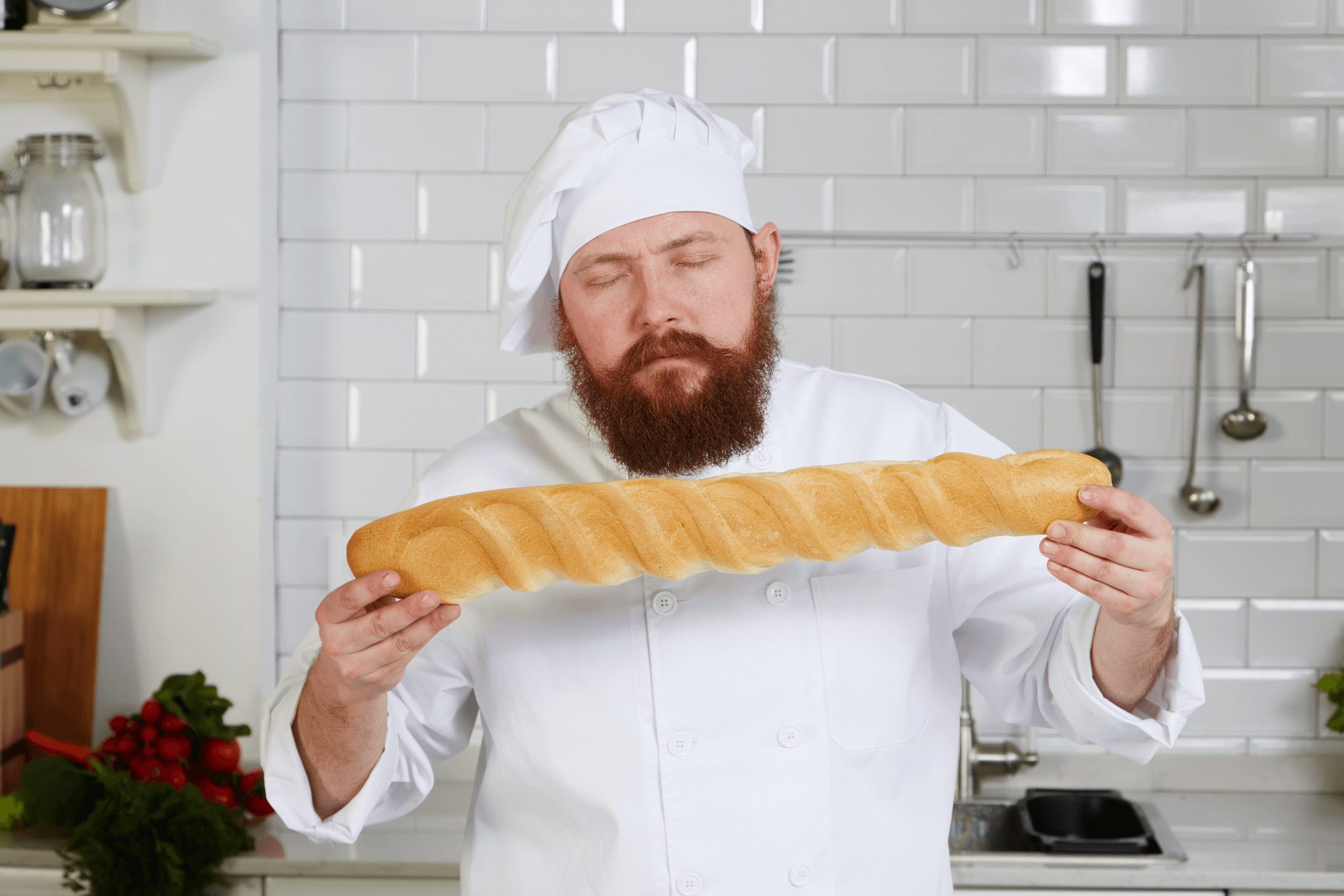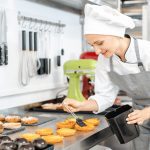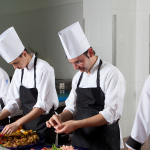Bread comes in many different flavours, types and sizes. We are going to look into the different areas of bread and look into the basics of baking bread.
Through practice in baking bread at home, the more knowledge you will gain about the features and characteristics of the dough.
As you work more and more with dough the better understanding you will have.
This will result in a better quality of your finished products and your skills in baking bread.
- All About Bread
- The Benefits Of Making Bread At Home
- What Are The Types Of Bread Baking Grains
- Understanding The Types Of Bread And Basic Chemistry
- The Bread Leavening Agents And The Sourdough Starter
- Getting To Know Bread Baking Ingredients
- What Is Yeast The Fungus That Helps Dough To Rise
All About Bread
What is bread?
Bread is a basic food prepared by cooking flour, water and possibly other ingredients. In the UK doughs are mainly baked, however In other countries bread can be fried, steamed or baked on a hot surface.
Doughs can be unleavened or leavened, which means it is using a rising agent to produce a leavened bread. Although in many international countries the bread can be a flatbread with no rising agent or also known as unleavened bread.
Flour, Salt, water and leavening agents including baking soda or yeast are basic ingredients for making bread and other dough products.
It is also possible to add many other ingredients such as sugar, milk, spice, fruit, nuts like pine nuts, vegetables such as spring onions or seeds like sesame seeds.
Bread is one of the oldest cooked foods in the world, dating back thousands of years. Evidence of leavened bread has been found dating back tens of thousands of years.
Facts about bread
Fresh bread is attained for its quality this includes the taste, texture and the aroma of the bread. It is essential to keep bread fresh for it to keep its quality when bread has dried and stiffened it is known as becoming stale.
To keep bread fresh it can be wrapped in a cling film or a paper wrap.
Also, a way to prevent the bread from becoming stale is to keep it in a bread box. Bread that is being kept in a warm moist environment has the potential to grow mould easily.
Keeping the bread in a fridge will slow down the growth of unwanted mould.
The soft inside part of the bread known as the crumb. The small pieces that fall from a bread product are known as the crumbs.
The crumb and the breadcrumbs are two different parts of a bread product. Also, the outside part of the bread is described as the crust.
How to serve bread
- Bread can be served at a range of temperatures, hot or cold and as soon as it is baked. Bread can also be toasted in a toaster or under a grill. Mostly bread is eaten using your hands.
- Although it may be part of a dish such as a focaccia topped with a tomato salsa. In this case, a knife and fork may be needed.
- It can be eaten on its own or together with other foods, for example, soup, olive oil + balsamic vinegar or sardines.
- It can also be made into a sandwich with a broad range of possible fillings including cheese, vegetables, egg, meat or fish. A sandwich will be two slices of bread with a filling in between.
Bread at home, All about the crust
The exposed dough will form the crust of the bread during the cooking process. Through the cooking it will be browned and hardened, the proteins and sugars in the dough will caramelise due to the intense heat on the surface of the bread.
The broad range of bread varieties will form a different type of crust during cooking. Due to the type of bread and the way it is being baked.
When baking bread at home it’s important to understand, bread can be baked using a dry heat, although in some cases a jet of steam can be aimed towards the dough during cooking to create a quality crust.
Some crusts can be difficult to eat especially for young children or people with sensitive teeth. The crust of the bread will always have a different colour when compared to the rest of the bread.
Benefits of making bread at home
To be able to make bread successfully you first need to understand the broad range of bread out there.
When making bread you will need to know the different characteristics of each bread type including their appearance.
And also how to follow the recipes to get the best flavour and texture from the bread. People have been making bread for hundreds of years at home and are very important in professional kitchens.
Essential bread making tips
The main difference between homemade bread and bread that is made in large quantities in a bread factory is commercial bread will be made to a uniform flavour and texture. Factory made bread is produced on a large scale and will stick to the uniform recipes.
These recipes will use a large quantity of yeast which helps to produce lots of bubbles within the bread, this leads to the light texture of the bread.
Also, many factory breads will be made with a lower quality grain that will also lack the essential nutrients.
Commercialised bread is produced to earn the highest profit possible, this may result in lower quality cheap ingredients being used.
Manufactured bread may also contain preservatives to help boost the shelf life of the bread. Ingredients used in commercial bread that you should be cautious about include; high fructose corn syrup, dicalcium phosphate and ammonium chloride.
Advantages of making bread at home
- Bread that is made at home or in a professional kitchen has many advantages over commercial bread.
- Making the bread by ourselves means we can use high-quality ingredients to achieve a better flavour, taste and texture.
- By adding all the best ingredients into the dough mix, ultimately a higher quality and tasting bread will be created.
- There are some areas you need to be aware of these include; different flours will function differently.
- Various flours will have their own characteristics, such as whole wheat flour will use less flour than white flour in a recipe.
Italian bread can be made using a range of seasonings. When creating an Italian bread try replacing the salt with garlic salt
Seasonings such as rosemary or oregano can be stirred into a dough, try to experiment with a range of ingredients.
Recipes can also be increased, so if you are following a recipe for 1 loaf try doubling all of the ingredients to make 2 loaves. Making homemade bread is a great way to have your own breadcrumbs.
Where to buy the ingredients for making bread
When creating your homemade bread you will need to buy your ingredients. There is a range of places to buy ingredients from including; The internet is a great place to find the ingredients you need, especially the speciality ingredients.
Also when shopping online you can have your products delivered to your door. Furthermore, if you are making a sourdough it is possible to buy a sourdough starter online and have it delivered.
To get a better idea of the range of bread you should visit different shops that sell bread, such as supermarkets or artisan bread shops. A great tip here is to ask the bakers a few questions to find out the special ingredients they use to achieve the bread appearance, texture and flavour that you are looking to create.
Try to experiment with homemade bread by adding condiments and sweeteners, and practising with various skills. A range of techniques and tools need to be learnt and used to achieve different results and types of bread.
Finally, homemade bread is convenient and easy to make and is an enjoyable learning experience for bread bakers.
Basic recipe for homemade bread
There are many different recipes for making bread, although it is best to start with the basics. A basic bread recipe can be built upon and improved to the specific bread requirements. Homemade bread is easily prepared, contain more nutrients and will have a unique result.
Homemade bread has an authenticity about them that can’t be achieved by commercial bread making machines. Also, it is important to learn the basic skills and then develop your own recipes.
Basic Bread Baking Tips
Equipment and tools
- To start, you will need,
- A stand mixer,
- 1 big mixing bowl,
- A spoon,
- Spatula to work the dough,
- A set of measuring cups
- A set of measuring spoons.
- Also a bread baking tin and a damp cloth to cover the bread when rising.
The ingredients are;
- 2.5 cups of bread flour or all-purpose flour,
- A 1x 7-gramme sachet of instant or dry active yeast,
- 2 tablespoons of sugar,
- 1 teaspoon of salt,
- 1 cup of milk heated to 45 degrees Celsius,
- 2 tablespoons of olive oil,
- 1 egg,
- An extra ¼ cup of flour.
Always check the yeast package for correct temperatures of the mixing liquid. The different brands can vary
Getting to know the bread making process
Firstly, mix the yeast in 1 cup of milk at a temperature of 45 degrees Celsius. We will mix the dough using a stand mixer and dough hook, so in the stand mixer bowl add the flour, yeast, sugar and salt stir in the milk followed by the oil and the egg.
Next beat the mix on a high speed for 2 minutes then turn the mixer to a low speed and add about ¼ cup of flour or until the dough forms a mass.
The Kneading Process
Kneading the dough
The kneading of the dough is done next. Firstly, take a little flour in your hands and rub together and lightly flour the kneading surface. Take the ball of dough and place it on the floured surface and knead the dough for about 55 turns.
Kneading requires the dough to be punched flat and folded into a ball again over and over. Once the dough has been kneaded place it in the mixing bowl that has been lightly oiled and covers with the damp cloth and leave to rise for 45 minutes.
The dough should rise to roughly double the size depending on the yeast used. And knock the dough back down again and shape it to fit in the oiled baking loaf tin. The tin size is around – 20cm x 10cm.
The final steps for making bread
Cover the homemade loaf and tin with the damp cloth and leave to rise for around 50 minutes, the dough will rise to the top of the tin.
It is crucial that the towel is not too heavy and make sure it is damp enough so it doesn’t stick to the rising dough.
Preheat the oven to 190 Degrees Celsius, and bake the loaf for 30 minutes. If the loaf starts to brown too much, lightly cover the loaf in tinfoil.
Once the baking has finished removing the loaf from the tin to cool.
What are the types of grains used in bread baking
There is an art to baking bread, however, there is also a science to understand. Getting to know all the processes, types of grains, as well as the ingredients, will help to produce the freshest bread possible.
One important factor in bread baking is time, using time correctly will help to avoid bread turning rancid and other problems that may occur during milling and baking.
To follow are some tips on what are grains, freshly milled grains and preparation methods to help achieve the best results from your bread baking chemistry.
Getting to know the types of grains
The freshly milled flour that is milled from the whole grain berries has a range of vitamins, proteins and minerals, as well as being high in fibre.
To keep as many nutrients as possible from milled grains it is important to preserve the grain for as long as possible. The entire grain is preserved naturally inside its shell where naturally occurring vegetable oils are also captured. This helps prevent the grain kernel from spoiling.
As soon as the grain has been milled the flour can go rancid quickly due to naturally occurring vegetable oils being released.
Vitamin loss can happen after the milling process. Therefore to make the healthiest bread possible it needs to be baked soon after the flour has been produced. Flours have B and C complex vitamins that will reduce when the flour is left in storage.
Soft, hard and Durum Wheat
What are grains – Durum wheat
The high levels of protein in durum wheat create the yellow flour. This flour can also be known as semolina that may be used for; pasta, gnocchi or pizza.
What are the types of grains – Hard wheat
Another wheat that can be used to make bread is the hard white spring wheat, also known as golden 86 flour. This flour is cross-bred, the bitter compounds of the bran are bread out.
This makes the grain lighter and sweeter and makes a good option for a pizza dough or French bread.
What are grains – Soft wheat
Soft white winter wheat also is known as pastry wheat. This flour is ideal for cookies, pastries, muffins and cakes.
What are grains with high gluten
The grains with the highest gluten levels are Kamut, hard wheat and spelt. Using these grains will result in a high rising bread with the bread containing high levels of protein.
Hard wheat is also an option for making yeast bread. There is other nutritional grain out there, however, these will need to be mixed with wheat to create yeast bread.
More about the types of grains
The type of grain used in a recipe and changing the grain used can result in a unique product. For example, using 15% – 20% of rice flour produces a crunchier cookie. Using a soft white wheat and red wheat mixed at a 2:3 ratio results in a soft yeasted roll.
Another example can be mixing oat flour and soft wheat at a ratio of 1:3 produces a cake flour that can be used to make light and fluffy chiffon cakes.
In bread recipes, it is possible to change the wheat flour for other grains or beans. This will result in a bread with its own characteristics and features. Certain grains do not have enough gluten inside them to successfully raise yeast bread, including spelt and Kamut.
This can be overcome by adding 1/6 cup of wheat flour to the mix to help the bread rise.
More about wheat flour
The highest gluten levels of the flours are within the wheat flour. Gluten is a type of protein in flour. It is this part of the grain that creates the elasticity when the dough is kneaded.
The gluten traps the carbon dioxide made by the fermenting yeast and this will give the bread its texture and rise.
Types of bread and basic chemistry
There are many different bread types out there, each one having its own specific features and characteristics. Different cultures all over the world have their own tastes in bread and how they like to eat the product.
Bread is made tailored towards the preference and the personal needs of the people.
Understanding the types of bread
Having a good knowledge of the qualities of each type of bread will help you to prepare them. Also with experience in preparation and cooking, you will have fewer problems and produce bread of better quality.
Bread from around the world
Most cultures all over the world have their own popular bread preparation and cooking preference.
These include Asian countries where steamed bread, noodles or rice are popular. However, in the UK bread is usually made by making a dough with wheat flour and cultured yeast. The dough will be left to rise and baked in an oven.
Due to its high level of gluten, the main grain to be used in bread baking is the common wheat. Although bread can be made from a range of flours from other wheat species, these include emmer, barley, rye, oats and maize.
White bread is made using the common wheat. The other types of wheat are used to make a range of bread; Such as spelt bread – popular in Europe, emmer bread is popular in middle eastern countries.
And Canadian bread is a healthy bread with a high protein content.
Getting to know the different bread types
White bread is made from flour that uses the centre of the grain, this is called the endosperm. Also, brown bread is made using the endosperm and around 10% bran.
Wholemeal bread uses the whole of the wheat grain or the bran and endosperm. Wholemeal bread can also be known as whole grain or whole wheat bread.
- Wholegrain bread – has many of the characteristics of white bread and wholemeal bread. Wholegrain will have whole grains added to the recipe to boost the fibre content.
- Roti – A bread popular in south Asia is known as roti, this is similar in characteristics to the naan bread
- Granary Bread – Granary bread is made from granary flour. Other ingredients also include brown flour or malted wheat flour, wheat germ and whole grains.
- Unleavened Bread – Unleavened bread does not use raising agent. The recipe for the dough will not include any yeast or leavening ingredient.
- Rye Bread – The rye bread is made by using different levels of rye grain in the recipe. Furthermore, this type of bread will have a higher fibre content than most other bread types.
- Quick Bread – These bread are a type of bread that can be produced at a faster rate than usual. These are chemically leavened bread, these types of recipes will need baking powder or baking soda. The recipe will also need a balance of alkaline and acidic ingredients. Examples of the quick bread include; muffins and pancakes.
A range of different culture breads
There is a broad range of varieties of bread including; chapattis, naan, brioche, baguettes and tortillas. Some examples of bread types around the world are as follows:
- Mexico – A common food being the tortilla, other bread types include the pan dulce and Bolillo.
- The Philippines – A common bread being the pan de sal, this is a rounded bread.
- Peru – A common way to eat the sweet bread of Peru is with hot chocolate and butter.
There are many other examples of specialist bread types in specific cultures. Other countries such as; Scotland, France, Spain and Italy all have their own style of bread baking.
The formulation of bread
To successfully make bread, a basic understanding of the chemistry involved and the composition of bread is needed. There is a range of ingredients used that each has a relative effect on making bread products.
Consequently being able to get this right by choosing the correct ingredients is essential to the process.
A well-balanced recipe will result in delicious bread that will keep for several days. So by learning how to balance the ingredients, you will achieve the most benefits possible.
Introduction to bread chemistry
When making bread it is very important to have the correct quantities of flour and water. These two ingredients will create the crumb and texture of the bread, these will change with the amount of water and flour used.
Bakers have a system they used called bakers percentage or bakers math. This is a method of following recipes and creating a formula. The baker will measure all of the ingredients in weight and not volume.
By measuring in weight the recipe will become more accurate and consistent than measuring by volume. Also, it is easier to measure any dry ingredients by weight.
The baker’s maths always has the flour set at 100% and the rest of the ingredients will have a percentage of this according to weight. A typical percentage table can have water set at 50%, this will result in a light and fine-textured bread.
In addition, many artisan bakers will typically set their water percentage at 60% – 75%. Furthermore, in bread recipes using yeast, the higher water percentage will lead to CO2 bubbles and a coarser breadcrumb.
To make a regular loaf of bread 500g of flour can be used.
Getting to know bread flour
What is flour? Flour is made by grinding down a specific grain to produce a powdery consistent form. Also, flour is the main ingredient, giving the bread structure in the bread baking process.
Due to the many flours that are made from grains which include: rye, maize and barley. The most common flour to use in bread baking is the wheat flour. Each individual grain will add to the bread protein and starch content.
Wheat flour is made up of starch, 3 water-soluble protein groups and 2 nonsoluble protein groups. The water-soluble protein groups are; globulin, albumin and proteases. The non-water soluble groups are named gliadin and glutenin.
Firstly once the flour is mixed with the water, the water-soluble proteins will dissolve. This creates a reaction triggering the gliadin and glutenin to form the structure of the remaining dough.
When the bread is kneaded it will create strands of chain-like molecules from the glutenin and the gliadin will form bridges between the gluten strands. Also, the network created by the two is known as gluten, which enhances the quality of the dough.
Bread liquids
Most liquids can be used to create the dough for bread baking. Although water is a common liquid to use. Different recipes will need their own amount of liquid, a typical recipe using yeast may use around 1 cup of liquid to 3 cups of flour.
Although the ratio will depend on the leavening method, such as steam leavening which will use a ratio around 1-part liquid to 1-part flour measured out in volume. A range of liquids that can be used includes; fruit juice, beer, or dairy products.
These liquids can add extras such as added fats, leavening agents and sweeteners.
Advice on bread recipes
In conclusion, many bread recipes will use different quantities, however, it is important to stick to the ratios given. And with practice in using recipes, it is possible to change them to produce the consistency, texture and flavour you prefer.
Many recipes used all over the world will use a range of ingredients to give a unique and creative final product.
Bread leavening agents and the sourdough starter
One of the most important parts of the bread making is the leavening process using the bread leavening agents. This reaction is an important part of giving bread its quality, in texture and flavour.
It is important to understand how this process works. The same technique is generally used in most cultures all around the world. In some places such as the middle east unleavened bread will also be served.
The bread leavening process
To follow are some steps to help you appreciate the importance of bread leavening agents including yeast and tips on how to begin using yeast.
Bread leavening without yeast
There are several ways to leaven bread without yeast, using other bread leavening agents. The two most common methods are
- The method of using baking powder or a self-raising flour that may include baking powder.
- This method involves adding an acidic ingredient such as baking soda with buttermilk. The reaction of the baking soda and the acid with create the gas.
This type of leavening is used when making soda bread and for a fast bake bread. This method is used more in the making of sweet bread or muffins.
On bread leavening with yeast
The many bread leavening agents include yeast. Which is used in the leavening of a range of loaves of bread and is a single cell fungus.
The species of yeast used in bread leavening is called Saccharomyces cerevisiae, this is the same type as used in the brewing of alcohol. In the reaction, the yeast will ferment carbohydrates in the flour and any sugar. This will create the carbon dioxide.
More on yeast and bread leavening agents
The sourdough and the baker’s yeast method of making bread follow a similar process. The baking liquid, such as water is combined with the salt, flour and the leavening ingredient.
Other ingredients like fruits, nuts and seeds are not essential to baking bread, however, these add flavour and texture. Once the dough has been mixed it is allowed to rise at least once. Bakers will often knock the dough back once risen and let it rise again.
The dough is formed into loaves in the required style and baked in the oven.
Another process of making loaves of bread is using the straight dough or the direct dough method. In this case, all of the ingredients will be added in a single step and allowed to rise and then baked in the oven.
The starter method for making dough is another option. This is when the water, flour and raising agent are mixed at least one day before baking. This allows the dough to ferment.
All the other ingredients will then be added and the rest of this method is similar to the straight dough process.
The finished product will be more flavourful with a better texture.
Steam leavening
Bread can also be leavened by steam expanding very quickly within the bread. This is a basic method, however, it can be unpredictable. The most common type of bread that uses this method is the popover.
Also, steam leavening can be done using most leavening agents including sourdough, egg snow, yeast and baking soda. Although this method is unpredictable due to the steam only being created once the bread is baked.
Sourdough and leavening
The range of leaving agents used in baking all have their own properties. This results in different characteristics of the end product for each leavening agent used.
The taste in sourdough is not produced by the yeast it is the lactobacillus ( a non–spore-forming bacteria) the yeast lives in association with the lactobacillus.
The lactobacillus feeds on the leftover products of yeast fermentation. This makes the part that turns sour by the excretion of lactic acid. Also, this will protect everything from spoiling.
The baker’s yeast that is used in the baking of bread, is a specific strain of yeast. This is not naturally sour because of the absence of the lactobacillus and needs to go through the process to form a sourdough starter.
All loaves of bread were sourdough up to the 19th century until the process of rising through microbes was fully understood. As soon as this development was made by scientist’s yeast was taken on by bakers all over the world.
Learn about the different grains used in bread baking.
Sourdough bread essentials
Sourdough bread is made using a sourdough starter. The sourdough starter is produced by the Lactobacillus and yeast this is where the lactobacilli and yeast live and is similar to a pancake mixture.
A sourdough starter can be managed continuously by removing a part of the starter to be used and adding fresh flour and water back into the mix. Starters can be kept for long periods of time.
Some starters have been passed down from generation to generation in baking families. Due to the sourdough starters growing potential it is possible to buy small pieces from specialist suppliers and growing them.
A traditional method for the culture of sourdough in bread making families. Is to have the sourdough prepared and keeping a piece back to use for the following week.
If baking once a week then a small piece of sourdough will be kept back each week and grown for the next week. The starter will be saved from the previous week and mixed with the new ingredients and left to rise.
Salt risen bread – bacteria
Salt risen bread uses a leavening method that does not use yeast. This process is not as accurate as using yeast as a leavening agent and needs close attention. This style of bread making will produce a cheese-like flavour and a smooth texture.
Fats and preparation
There is a broad range of bread preparation methods, and this will vary from culture to culture. The finished product will change depending on the preparation methods used.
Also, the body, crust and the texture will vary with each different method or ingredient used. And some bakers will have their own methods of producing original types of bread.
The gluten development within the bread can change depending on the fats used. Fats including vegetable oils, butter and lard will coat the single protein strands that help hold the structure together.
By using too much fat in a bread dough recipe then the proteins structures may separate.
Bread baking ingredients
When you are making bread you will be using a variety of bread baking ingredients and tools. To produce bread that is good quality and full of flavour, you need to understand the effects of each ingredient.
It may be surprising to know that some of the most common ingredients can have a major impact on changing the nature of the bread.
This can happen even with only a small change in the bread baking recipe. Many of these ingredients can be found in local stores or online. Also, specialist items such as fresh yeast can be found online.
To follow are some tips and advice about bread baking ingredients. Also, find all about the sourdough starter.
Sweetening your bread dough
To achieve a much tastier finish to the bread a liquid sweetener can be added. Two of the most common options for the liquid sweeteners are honey and molasses.
Firstly the sugars are a food source for the yeast, this helps the yeast to create the carbon dioxide which raises the bread. Sweeteners will give the bread a moistness, a quality appearance and a longer shelf life.
There is a range of other sweeteners including barley malt syrup and maple syrup.
Due to the high temperatures in the bread baking process its recommended to be careful when using honey as it can scorch the bread.
A typical bread loaf recipe will use around 1/3 cup of honey for two loaves.
Salt – An essential bread baking ingredient
Salt is essential to a quality bread product. However, be precise with the quantity as too much and the bread will not good to eat. And using too little will make the bread tasteless. In general, the salt will enhance the flavour of the bread.
Also, the salt will manage the fermentation process. Table salt, mineral salt or refined sea salt are all useable in bread baking. Although do not add the salt to the yeast as it is dissolving as this can stop the yeast growing.
A typical bread recipe uses around 1 tablespoon of salt for 2 loaves.
Other ingredients used in bread baking
To help keep the bread moist and soft lecithin can be added. Lecithin slows the oxidation of the liquid ingredients and is also a binder within the dough. Lecithin comes in liquid, powder, or granular form and comes from soybeans.
A typical recipe for one loaf of bread will use 1.5 tablespoons of liquid or granular lecithin as a binder. The powdered form quantities may vary, so read the guidelines on the packet.
Toasted barley has a range of sweet derivatives used in bread baking.
These include malt, barley malt syrup or diastatic malt powder. When these are added to the dough the bread will have a boosted appearance, shelf life and extra added nutrition.
Although if too much is added to the recipe then the bread can become very sweet, bitter, dense or gummy.
Another ingredient is High protein wheat which provides essential wheat gluten or gluten flour. And also acts as a binder, resulting in a more elastic dough.
More gluten may need to be added if the flour that is being used as a lower protein content than 16%. Adding gluten also helps compensate for the damage done to the bread gluten due to the jagged edges of the bran.
The edges become jagged during the milling procedure. However, adding too much gluten will result in a rubbery and tough bread. A typical recipe for 1 loaf will need 1 to 2 tablespoons to be adequate.
Essential bread baking ingredients
There is a range of ingredients that can be used when making bread. The core ingredients and other added ingredients. It is important to understand the characteristics of each one so that you can completely take advantage of the process.
By doing so your bread baking will produce a higher quality of the product, more flavour, texture and overall quality. Each individual ingredient will develop a certain feature, that you will see in the finished bread.
To follow are some pieces of advice about what can be seen.
About yeast – bread baking ingredients
For yeast to grow correctly it will need food, moisture and warmth, the temperature needs to be around 38 – 44 degrees Celsius for best results. Yeast reacts well with water and sweeteners such as honey, sugars and molasses.
In the reaction, yeast will ferment sugars into carbon dioxide and alcohol. During this process, the gas is trapped inside the gluten network. This leads to the bread rising until all of the oxygen is consumed or the fermentation/baking has killed the yeast.
Yeast is a microscopic fungus that makes bread rise. Also yeast is a living plant.
There are two main types of yeast, fresh yeast and dry yeast. The most common yeast is the dry yeast, which consists of two main types the regular active dry yeast and the instant yeast. The dry yeasts have been dried until the yeast has been deactivated and not killed.
Although, instant dried yeast has been dried at a lower temperature so that it can produce more live cells that act faster with water or flour.
Instant dry yeast can be added straight to a dry dough mix. Unlike the active dry yeast that needs to be activated.
Active dry yeast
Before adding active dry yeast to the other ingredients of the dough we need to consider. The yeast needs to be softened in warm water for 5 – 10 minutes and by adding sweetener. This is due to the tough outer shell of the active dry yeast.
Glutathione in the wheat germ can break down the gluten, there is a small amount present in the yeast. Although this does not affect the quality of the finished bread even though it is inside the yeast cell.
In the wrong conditions, the glutathione can leak out of the yeast cell, which can cause lower quality of the product. To help prevent this the dissolving water needs to be at least 38 degrees Celsius if using the active dry yeast.
The glutathione inside the yeast cell can leak out very quickly in cool water. Furthermore, this will lead to a weaker dough.
When the instant yeast is being used the batter or flour temperature will need to be between 24 – 32 degrees Celsius. This will stop the dough from overheating and the yeast being destroyed.
Liquids used in bread baking
By far the easiest and fastest liquid to use is water. By adding water to the dough the texture of the grain tends to be tough. Also, the flavour becomes more obvious.
Milk can be used and this helps the bread to rise faster. Furthermore, milk helps the bread have a finer texture and a longer shelf life. To use milk it will need to be heated to scalding point.
You can also use buttermilk, this type of liquid will give a tenderer and a better quality taste to the bread. Other liquids that can be used include yoghurt – although when using yoghurt it needs to be a liquid replacement for around 50 % of the liquid.
Vegetable juices can be added to add nutritional value and improve the taste. Such as apple, orange or tomato juice.
Finishing ingredients used in bread baking
Further bread baking ingredients. To provide an extra moistness and crunch to the bread, oats or oatmeal can be used. This will also add to the quality of the bread and give it a tastier finish.
A typical recipe will use 1 cup of rolled oats for 2 loaves. To use the rolled oats pour over boiling water and allow to cool. Also to give a quality finish whey can be used in liquid form.
Whey is a by-product from dairy products and contains milk sugar, protein and minerals. Whey will help the bread product browning and will add a little sweetness to the finished product.
What is yeast: The fungus that helps dough to rise
What is yeast, there are 2 main types of yeast, fresh yeast and dry yeast. Although dry yeast has several different kinds. The two main dry yeasts are regular active dry yeast and instant yeast.
The main difference between these two dry yeasts is that active dry yeast has a larger particle and will need dissolving in water before being used.
The instant yeast can be mixed straight into the dry dough mix due to its finer texture. These two dry yeasts can be used alternatively depending on the baker’s own recipes needs.
What is yeast?
The standard bread recipes can vary in quality by using different types of yeast, and this can change the characteristics of the finished bread product.
Instant, active and fresh yeast
Instant yeast can be known by several different names these include quick rise yeast, rapid rise yeast, fast rising yeast or bread machine yeast. The instant type of yeast will have a quicker rising time for the dough.
Instant yeast has a much faster rising time than the dry yeast known as active dry yeast and fresh yeast.
The typical bread recipes can be altered in quality by changing the type of yeast in a dough and also the amount of yeast used in the product. Using less yeast in a standard recipe will result in a heavier finished bread and using more can result in a lighter finished product.
Instant yeast has a much faster raising time when used in bread due to the finer grains. These grains can absorb moisture quicker than the larger grains of active dry yeast.
The instant yeast creates carbon dioxide from the sugars and starch in the dough. The carbon dioxide creates the bubbles that cause the dough to stretch and expand.
What is yeast? about fresh yeast
Fresh yeast can also be known as cake yeast, wet yeast, fresh yeast or compressed yeast. It has been used by bakers for many years and is still used today. However fresh yeast is a lot harder to find and will be found mainly in specialist stores.
Due to the limited availability of fresh yeast many bakers use dry yeast in their baking.
About active dry yeast
Active dry yeast has a larger grain size than the instant dry yeast. It is crucial that the active dry yeast is proofed in water before using. Due to the larger size of the grain. The various brands of active dry yeast will have their own advice on water temperature for the proof. Although the temperature is usually around 36 – 46 degrees Celsius.
Active dry yeast can be stored at room temperature if unopened for up to a year. Also, the yeast can be frozen, this will give it a much longer shelf life. Active dry yeast can be stored directly in the freezer in its sealed packet. A tip here is that the yeast can be used directly from the freezer without being defrosted.
If you have opened the active dry yeast, it will have a shorter shelf life by up to 50 % of an unopened packet. The yeast will lose its power if stored at room temperature in an unsealed packet.
Dry yeast can be exchanged for instant yeast or bread machine yeast. The same quantities can be used if exchanging the type of dry yeast.
About instant yeast
Instant dry yeast is a good choice of yeast to use in bread machines. It is the easiest yeast to use as it can be mixed straight into the dry ingredients. It does not necessarily need to be mixed in warm water first. Instant dry yeast has finer granules than the active dry yeast.
The liquid part of the dough recipe should be warmed to around 48 – 55 degrees Celsius to make the dough. The instant yeast will have already been added to the dry ingredients.
A typical bread recipe will use 1 packet of the instant dry yeast.



















